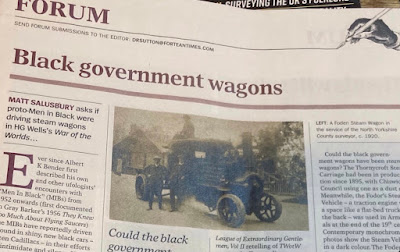Saturday, 1 February 2025
Black government wagons in The War of the Worlds
This article appeared in Fortean Times, FT
EVER SINCE Albert K. Bender first described his own and other ufologists' encounters with "Men In Black" (MIBs) from 1952 onwards (first documented in Gray Barker's 1956 They Knew Too Much About Flying Saucers,) the MIBs have reportedly driven around in shiny, new black cars – often Cadillacs – in their efforts to intimidate and silence UFO witnesses.
The cars the Men In Black arrive in are even said to smell new. Investigators report their attempts to trace such vehicles from their licence plates reveal no such registration exists. These strange black vehicles were hard-wired in MIB mythology from the beginning. Much has been written about how sci-fi imagery prefigures tropes within ufology, while Jenny Randles (FT 447;29) has written recently on how secret experimental military tech and Cold War anxieties affected the UFO phenomenon. I have spotted a turn-of-the twentieth century precursor to the shiny, new black cars used to convey the MIBs, from the dawn of science fiction when the genre was still known as "scientific romance."
There's a scene in Book 1 Chapter 12 of H.G. Wells's The War of the Worlds (TWotW, 1895-1897) – a chapter entitled "What I saw of the destruction of Weybridge and Shepperton." The narrator witnesses "Three or four black government wagons, with crosses in white circles, and an old omnibus, among other vehicles, were being loaded in the village street."
Could the "black government wagons" – noticeable and identifiable, needing no further explanation to the readers of 1897 – have wormed their way into the collective sub-conscious to give rise to MIB lore? And what could the "black government wagons" have been, at a time when "government" was much smaller than it is now.
Illustration by Warren Globe from the original edition of The War of the Worlds, serialised in Pearson magazine. Out of copyright.
Horse-drawn black police wagons to haul away detainees were a thing as early as the 1860s, with engravings from the Illustrated Police News and other publications showing Fenians attempting to hijack such vehicles and rescue condemned prisoners. But such incidents were three decades before TWotW, first serialised in 1897 by Pearson magazine before publication as a book soon after, with the action taking place starting on a then near-future New Year's Eve 1899. Surviving photos or illustrations of dark-coloured police wagons in the late 1890s seem rare.
And anyway, they were black government wagons, not police wagons in TWotW. They don't seem to have been ambulances either – surely had they been ambulances they would have been described as having red crosses on them. Alan Moore and Kevin O'Niell, in their 2003 The League of Extraordinary Gentlemen, Volume II graphic novel retelling of TWotW portray the Extraordinary Gentlemen themselves emerging from a sinister, shiny, hearse-like black carriage bearing "VR" initials and a crown. An equally glossy black two-door Hanson cab bedecked with a Masonic compasses and set square logo conveys devious spymaster Campion Bond.
In those days, "government" basically meant military, foreign policy or espionage. New and suitably sinister government agencies then forming could have deployed Wells's black government wagons. The Special Irish Branch of the Metropolitan Police, set up in 1883 to combat the "Fenian menace", was at the time of TWotW
Invasion paranoia was in the air too. Wells parodied a rich vein of "invasion literature", kicked off in 1871 by George Tomkyns Chesney's bestseller The Battle of Dorking, in which Germans invade England' south coast. Some 60 "invasion literature" works followed, although by the time TWotW appeared, the invader was more likely French or Russian.
The better-known illustrations from TWofW, for the 1906 edition by Henrique Alvim Correa. He contacted Wells to tell him he thought he could better illustrations than Globe's.
Could the black government wagons have been steam wagons? The Thornycroft Steam Carriage had been in production since 1895, with Chiswick Council using one as a dust cart. Meanwhile, the Foden Steam Vehicle – a traction engine with a space like a flat-bed truck at the back – was used in Army trials at the end of the 19th century. Contemporary monochrome photos show the Steam Vehicle in a dark colour. Foden's Steam Lorry made its appearance in 1900, with War Office trials of the vehicle the following year, it also appeared in a dark colour in contemporary photos. The Lancashire Steam Motor Company (later Leyland) was already turning out steam vans by then, while the Automotor and Horseless Vehicle Journal had been circulating since 1896.
That dark coloured paint job for contemporary "government wagons" though, could have been khaki. The militia and yoemanry units massacred by Martian heat rays in TwotW would have been the last British army units to go to war wearing redcoats. Khaki uniforms had already made their appearance on the battlefield for regular units fightings in the Boer War in 1900. Steam lorries still in use at the outbreak of World War One, with "WD Roads" stencilled on the side, are known to have been painted in khaki. In any event, it’s intriguing to find the shiny black vehicles conveying the Men in Black prefigured over a half century earlier, with fictional "black government wagons" deployed in response to the equally fictional incursions of extraterrestrials.
A World War One era steam lorry painted in khaki with "WD" (War Department) stencilled on the side. Wikimedia Commons, Public Domain
©️ Matt Salusbury 2024
Subscribe to:
Post Comments (Atom)







No comments:
Post a Comment